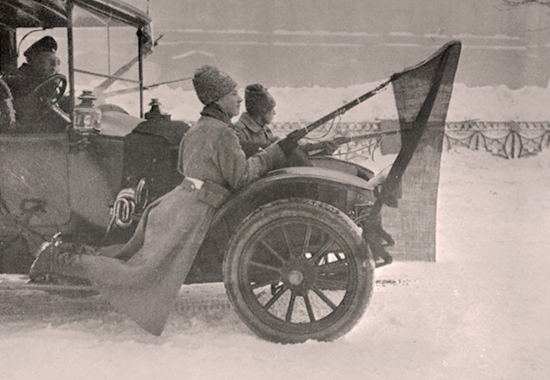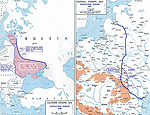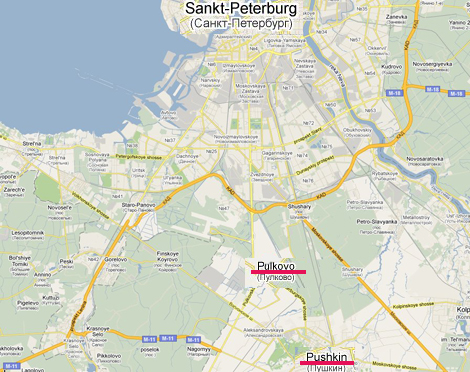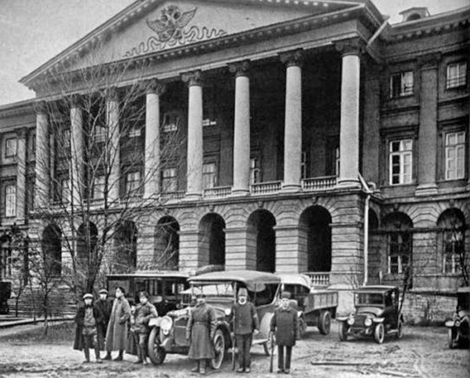|

SOLDIERS ARE JOINING THE REVOLUTION
Russian History 1917
Timeline of the Russian Revolution
of 1917
|
|
January 22, 1917
(January 9,1917
 old style)
old style)
Bloody Sunday anniversary.
Strikes and demonstrations take place commemorating
 Bloody
Sunday. Bloody
Sunday.
February 12, 1917
(January 31,1917
 old style)
old style)
A new strike wave in
 Petrograd. Petrograd. |
February 27, 1917 (February
14,1917
 old style)
old style)
Last meeting of the
 State Duma.
State Duma.
March 8-12, 1917 (February
23–27,1917
 old style)
old style)
March Revolution (February Revolution)
The first stage of the revolution of
1917 overthrows the monarchy and replaces it by the
 Provisional
Government, which is to remain in office until a democratic
parliament will be arranged.
Provisional
Government, which is to remain in office until a democratic
parliament will be arranged.
March 8,
1917
(February
23,1917
 old style)
old style)
International Women's' Day. Women textile workers in
 Petrograd go on
strike and gather in the streets to protest against food shortages.
Petrograd go on
strike and gather in the streets to protest against food shortages.
The strike spreads to other factories where workers were just
waiting for a spark. The Revolution has begun.
March 9, 1917 (February
24,1917
 old style)
old style)
In
 Petrograd, approx. 200,000
workers are on strike now.
Petrograd, approx. 200,000
workers are on strike now.
March 10, 1917 (February
25,1917
 old style)
old style)
General strike. Students and many others are joining the activists
in the streets. The crowd demands Russia's exit from
 WWI and the Czar's abdication.
Shootings break out and revolutionaries are getting arrested.
WWI and the Czar's abdication.
Shootings break out and revolutionaries are getting arrested.
March 11, 1917 (February
26,1917
 old style)
old style)
Government troops are ordered to open fire on the protesters. The
troops obey and hundreds are killed.
Petrograd soldiers revolt.
 Czar Nicholas II dissolves the
Czar Nicholas II dissolves the
 Duma.
Duma.
March 12, 1917
(February
27,1917
 old style)
old style)
Soldiers in other cities join the
revolt, many follow the demonstrators in the
streets, others just go home, some shoot
their officers.
Prisoners
are freed from jail, police stations are set
on fire, as are portraits of Nicholas II and
tsarist emblems.
One of the
freed prisoners, and one whose cell door
they should've kep locked, is
Felix Dzerzhinsky.
We will meet him again on
 December
20, 1917. December
20, 1917.
In
 Petrograd,
the riot of the workers joins the riot of the soldiers.
The Petrograd Soviet of Workers' and
Soldiers' Deputies is founded. (
Petrograd,
the riot of the workers joins the riot of the soldiers.
The Petrograd Soviet of Workers' and
Soldiers' Deputies is founded. ( What is a Soviet?)
What is a Soviet?)
Against the
Czar's orders, members of the dissolved
parliament (the
 Duma)
form the
Temporary Committee
of the State Duma and prepare to
take complete power. Duma)
form the
Temporary Committee
of the State Duma and prepare to
take complete power.
March 14, 1917 (March 1,1917
 old style)
old style)
The Petrograd Soviet of Workers' and Soldiers' Deputies
issues Order No. 1, commanding the Russian armed forces
to exclusively obey orders that have been approved by the Soviet. The Provisional Government
is too weak to do anything about it and tries to look as unruffled as
possible for a sitting duck.
Order No. 1 reads as follows.
Order No. 1 of the Petrograd Soviet of
Workers' and Soldiers' Deputies
to the Petrograd District Garrison
To be immediately and
fully executed by all men in the Guards,
army, artillery and navy and to be made
known to the Petrograd workers.
The Soviet of Workers' and Soldiers'
Deputies has resolved:
1. In all companies, battalions, regiments,
batteries, squadrons and separate services
of various military departments and on board
naval ships committees shall be immediately
elected from among representatives of the
rankers of the foregoing units.
2. In all units which have not yet elected
their representatives to the Soviet of
Workers' Deputies, one representative from
each company shall be elected. All
representatives, carrying appropriate
identity cards, are to arrive at the
building of the State Duma by 10 a. m.,
March 2, 1917.
3. In all their political actions, units are
subordinated to the Soviet of Workers' and
Soldiers' Deputies and their own committees.
4. All orders issued by the Military
Commission of the State Duma shall be
carried out, except those which run counter
to the orders and decrees issued by the
Soviet of Workers' and Soldiers' Deputies.
5. All kinds of weapons, namely rifles,
machine-guns, armoured cars and so forth,
shall be placed at the disposal and under
the control of the company and battalion
committees and shall by no means be issued
to the officers, not even at their
insistence.
6. In formation and on duty, soldiers shall
strictly observe military discipline;
however, off duty and formation, in their
political, civic and private life, soldiers
shall fully enjoy the rights granted to all
citizens.
In particular, standing to attention and
obligatory saluting off duty shall be
cancelled.
7. Likewise, officers shall be addressed as
Mr. General, Mr. Colonel, etc., instead of
Your Excellency, Your Honor, etc.
Rudeness towards soldiers of all ranks and,
in particular, addressing them as `thou'
shall be forbidden. Any violation of this
rule and all cases of misunderstanding
between officers and soldiers shall be
reported by the latter to the company
committees.
This order shall be read out in all
companies, battalions, regiments, ship
crews, batteries and other combat and
non-combat detachments.
Petrograd Soviet of Workers' and Soldiers'
Deputies.
March 15, 1917 (March 2,1917
 old style)
old style)
The Provisional Committee of the Duma forms the
 Provisional
Government.
Provisional
Government.
Prince
 Georgy Yevgenyevich Lvov
becomes first prime minister and minister of the interior of the
Provisional Government. He will quit his job on July 20, 1917.
Georgy Yevgenyevich Lvov
becomes first prime minister and minister of the interior of the
Provisional Government. He will quit his job on July 20, 1917.
The
Petrograd Soviet pledges loyalty to the
Provisional Government but mentions in the
fine print that it won't cooperate in case
its members can't agree. In effect, this
means two groups are ruling. This time is
also called the Era of Dual
Authority.
 Aleksandr F.
Kerensky becomes vice chairman of
the Petrograd Soviet and minister of justice
in the Provisional Government. Kerensky is
the only individual brave (or crazy) enough
to hold positions in both organizations.
Aleksandr F.
Kerensky becomes vice chairman of
the Petrograd Soviet and minister of justice
in the Provisional Government. Kerensky is
the only individual brave (or crazy) enough
to hold positions in both organizations.
 Nicholas II is on a train to
his residence, the summer palace, at Tsarskoe Selo and gets stuck in Pskov. The
Nicholas II is on a train to
his residence, the summer palace, at Tsarskoe Selo and gets stuck in Pskov. The
 Duma insists on Nicholas'
abdication and sends representatives
Aleksandr Ivanovich
Guchkov
and Vasilii
Vitalievich Shulgin to meet him there. Nicholas
complies and signs the papers.
Duma insists on Nicholas'
abdication and sends representatives
Aleksandr Ivanovich
Guchkov
and Vasilii
Vitalievich Shulgin to meet him there. Nicholas
complies and signs the papers.
Nicholas abdicates in favor of his
brother, Grand Duke Michael,
also spelled Mikhail.
March 16, 1917 (March 3, 1917
 old style)
old style)
Grand Duke Michael ponders the situation briefly and then
declines the job offer, which was smart but not smart enough to
ultimately save his life. He will be killed on June 12, 1918.
Back to March 16, 1917. Russia is no longer a monarchy.
March 17, 1917 (March
4, 1917
 old style)
old style)
Ukrainian nationalists respond to the political upheaval in
Russia and form the Central Rada,
or the Central Council. The Central Rada will issue their
First Universal on
 June 23, 1917.
June 23, 1917.
March 19, 1917 (March 6, 1917
 old style)
old style)
The Provisional Government announces amnesty for political
prisoners.
March 25, 1917 (March 12, 1917
 old style)
old style)
The Provisional Government abolishes the death penalty.
April 7, 1917 (March 25,1917
 old style)
old style)
Grain crisis. The Provisional Government issues a decree on
grain monopoly. Famine is in the air.
April 16, 1917 (April 3,1917
 old style)
old style)
 Lenin, Zinoviev and other
Bolsheviks arrives in
Lenin, Zinoviev and other
Bolsheviks arrives in
 Petrograd
coming from Switzerland. Lenin had left the country in 1900.
Petrograd
coming from Switzerland. Lenin had left the country in 1900.
April 17, 1917 (April 4,1917
 old style)
old style)
 Lenin presents his
April Theses, his agenda for the
continuation of the Revolution. He argues that the ruling
Provisional Government is unacceptable because the workers, and the
workers alone, should be the ones in power.
Lenin presents his
April Theses, his agenda for the
continuation of the Revolution. He argues that the ruling
Provisional Government is unacceptable because the workers, and the
workers alone, should be the ones in power.
May 1, 1917 (April 18,
 old style)
old style)
Foreign Minister
Pavel N. Milyukov (also
spelled Miliukov) sends a declaration to the Allies regarding the
Russian Government's war aims. The government's position is that of
being ready to quit the war without any ambitions regarding
territorial annexations. However, knowing that the French and the
British wouldn't be happy with that position, Milyukov attaches a note
of his own. Milyukov elaborates that Russia is still willing to "continue the
war until complete victory" and that Russia is very much interested
in expanding her territory.
This note is leaked to the press and
will cause the Provisional Government's first crisis.
May 3 - 4, 1917 (April 20 -
21,
 old style)
old style)
The April Days, also called the
April Crisis. Mass demonstrations in Petrograd and Moscow
against Pavel N. Milyukov's
declaration of war aims.
May 7 - 12, 1917 (April 24 -
29,
 old style)
old style)
Seventh All-Russian Conference of the Bolshevik party.
Lenin's April Theses are officially the party's program. The new
slogan is All Power to the Soviets.
May 15, 1917 (May 2, 1917
 old style)
old style)
Pavel N. Milyukov resigns
as foreign minister.
May 17, 1917 (May 4, 1917
 old style)
old style)
 Leon Trotsky
arrives from America.
Leon Trotsky
arrives from America.
May 18, 1917 (May 5, 1917
 old style)
old style)
The Second Provisional Government, also called
First Coalition Government, is formed. The seats are occupied
as follows
Lvov -
President and Minister of the Interior
Kerensky - Minister of War and Navy
(Socialist Revolutionist)
Chernov - Minister of Agriculture (Socialist
Revolutionist)
Pereverzev - Minister of Justice
Tereshehenko - Minister of Foreign Affairs
Shingarev - Minister of Finance
Nekrasov - Minister of Communications
Konovalov - Minister of Commerce
Peshekhonov - Minister of Supplies
Manuilov - Minister of Education
Skobelev - Minister of Labor (Menshevik)
Tsereteli - Minister of Posts and Telegraph
(Menshevik)
The First
Coalition Government will end on July 15, 1917.
June 12-16, 1917 (May 30 -
June 3, 1917
 old style)
old style)
The
First Conference of Petrograd
Factory Committees takes place and supports Bolshevik
policies. There will be four more conferences prior to the Bolshevik
revolution. See the next one on August 20 - 25, 1917 (August 7 - 12,
1917
 old style)
old style)
June 16 - July 7, 1917 (June 3
- 24, 1917
 old style)
old style)
The First All-Russian Congress of
Workers' and Soldiers' Soviets gathers. The Socialist Revolutionaries have the
majority, the Bolsheviks and the Mensheviks the minority.
June 23, 1917 (June
10, 1917
 old style)
old style)
The Central Rada, created
 March 17, 1917, issues their
First Universal, declaring Ukrainian independence.
March 17, 1917, issues their
First Universal, declaring Ukrainian independence.
July 1 -
11, 1917 (June 18 - 28, 1917
 old style)
old style)
 Kerensky's unsuccessful military offensive on the Austrian front, led by
Kerensky's unsuccessful military offensive on the Austrian front, led by
 General Aleksey Alekseyevich Brusilov. General Aleksey Alekseyevich Brusilov.
This military attack is also known as the
Kerensky Offensive, the
June Offensive (old style), the
July Offensive (new style), the
Summer Offensive, and the
Galician Offensive.
Check
 this event in the WWI Timeline.
this event in the WWI Timeline.
This map illustrates the Kerensky
Offensive.

Map 1917-8 WWI: Eastern Front
July 16-20, 1917 (July 3-7,
1917
 old style)
old style)
This time period is also known as the
July Days.
July 16, 1917 (July 3, 1917
 old style)
old style)
Mass demonstrators in Petrograd are making
noise for the Petrograd Soviet of Workers'
and Soldiers' Deputies and want the Soviet
to replace the Provisional Government.
Again, the
slogan of the day is All Power to the
Soviets.
July 17, 1917 (July 4, 1917
 old style)
old style)
Today the Bolsheviks are the
demonstrators. Chaos ensues and approx. 400
people get injured.
Bolshevik
leaders get arrested. To keep the
Bolsheviks in their place, the
Provisional Government spreads the rumor that Lenin is
a German spy. This little nasty had worked
like a charm against the Czarina and
should do the trick now. Lenin goes underground
in Finland.
He'll be back October 20.
July 20, 1917 (July 7, 1917
 old style)
old style)
 Prince Georgy Yevgenyevich Lvov
resigns as prime minister and minister of
the interior of the Provisional Government.
He had held this post since March 15, 1917.
Prince Georgy Yevgenyevich Lvov
resigns as prime minister and minister of
the interior of the Provisional Government.
He had held this post since March 15, 1917.
Kerensky becomes the new prime
minister. He will keep this office until
November 7, 1917.
July 25, 1917 (July 12, 1917
 old style)
old style)
The Provisional Government re-introduces the death penalty in
the army.
August 1, 1917 (July 18, 1917
 old style)
old style)
 Kerensky, as head of the Provisional Government, makes
Kerensky, as head of the Provisional Government, makes
 Kornilov commander in chief.
Kornilov commander in chief.
August 20 - 25, 1917 (August
7 - 12, 1917
 old style)
old style)
The
Second Conference of Petrograd
Factory Committees takes place. There will be three more
conferences prior to the Bolshevik revolution. See the next one on
September 18 - 23, 1917 (September 5 - 10, 1917
 old style)
old style)
End of August 1917 (Mid of August 1917
 old style)
old style)
 Kornilov,
the commander in chief of the Provisional
Government, sends troops direction Petrograd.
Kornilov,
the commander in chief of the Provisional
Government, sends troops direction Petrograd.
August 27, 1917 (August 14, 1917
 old style)
old style)
 Kerensky judges
Kerensky judges
 Kornilov's move as an attempted military
coup. He fires Kornilov from his post as commander in chief and
orders him to come to Petrograd, but with the quickness. Kerensky
makes himself the new
commander in chief.
Kornilov's move as an attempted military
coup. He fires Kornilov from his post as commander in chief and
orders him to come to Petrograd, but with the quickness. Kerensky
makes himself the new
commander in chief.
September 1, 1917 (August 19, 1917
 old style)
old style)
Kornilov refuses to come to Petrograd. He goes to Bykhov
instead, surrenders, and gets caged. He manages to escape later.
September 18 - 23, 1917 (September
5 - 10, 1917
 old style)
old style)
The
Third Conference of Petrograd
Factory Committees takes place. There will be two more
conferences prior to the Bolshevik revolution. See the next one on
October 23, 1917 (October 10, 1917
 old style)
old style)
October 20, 1917 (October 7, 1917
 old style)
old style)
 Lenin sneaks back into the country and arrives in Petrograd.
Lenin sneaks back into the country and arrives in Petrograd.
October 23, 1917 (October 10, 1917
 old style)
old style)
The
Fourth Conference of Petrograd
Factory Committees takes place. There will be one more
conference prior to the Bolshevik revolution. See the next one on
October 30 - November 4, 1917 (October 17 - 22, 1917
 old style)
old style)
Meeting of the Bolshevik Central
Committee. Lenin takes his vitamin pills and after 10 hours of debate
he convinces his comrades
that now is the time to seize power. Finally, they agree to an armed
insurrection.
October 25, 1917 (October 12, 1917
 old style)
old style)
The Petrograd Soviet forms the Military Revolutionary Committee.
October 30 - November 4, 1917 (October 17
- 22, 1917
 old style)
old style)
The
Fifth Conference of Petrograd
Factory Committees takes place, or the First All Russian
conference of factory committees.
November 6-8, 1917
(October 24–26,1917
 old style)
old style)
November Revolution (October Revolution)
Also
called the Bolshevik Revolution, the second stage of the revolution
of 1917 brings the
Bolshevik Party to power and establishes the Soviet Communist
government in Russia.
November 6, 1917 (October 24,1917
 old style)
old style)
It's the eve of the meeting of the Second
Congress of Soviets.
Lenin writes the
Central Committee
of the Bolshevik party to arrest the
Provisional Government members immediately.
Troops of the
Military Revolutionary Committee surround
the Winter Palace where the Provisional
Government is in session. Telegraph offices,
railway stations, and governmental buildings
are occupied without any noteworthy
resistance.
In the name of the Military Revolutionary
Committee, not in the Bolsheviks' name,
the Provisional Government is
overthrown.
November
7, 1917
(October
25,1917
 old style)
old style)
The Bolsheviks occupy strategic points in
Petrograd. Ministers of the Provisional
Government are arrested.
Kerensky
escapes to the front, appoints
 Dukhonin
commander-in-chief.
Dukhonin
commander-in-chief.
South from Petrograd,
the border between Bolshevik and
anti-Bolshevik forces runs between Tsarskoe
Selo and Pulkovo. Today, Tsarskoe Selo is part of Pushkin. Here is the Google map.

MAP
LOCATION OF PETROGRAD (SAINT PETERSBURG)
PULKOVO AND TSARSKOE SELO (PUSHKIN)
Google
Late in the evening, Lenin comes
out of hiding and joins his comrades at the
Smolny Institute, a former school converted
into the Soviet's headquarters.
Here is a
photograph of the Smolny building.

SMOLNY
INSTITUTE, PETROGRAD
St Petersburg Encyclopaedia
Lenin
announces the end of the Provisional
Government and the victory of the
revolution.
November
8, 1917
(October
26,1917
 old style)
old style)
Lenin
proclaims the new Bolshevik government, the
Council of People's
Commissars (Sovnarkom),
chaired by Lenin himself. Furthermore, new laws
regarding the war and the redistribution of land
are in store.
The
Russian Soviet
Federated Socialist Republic is
proclaimed.
See next events under
 Timeline of the Russian Civil War 1917.
Timeline of the Russian Civil War 1917.
More History
|